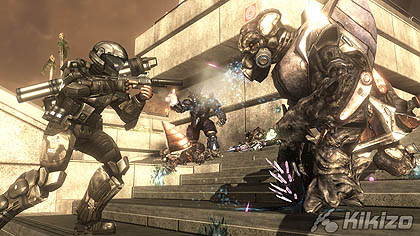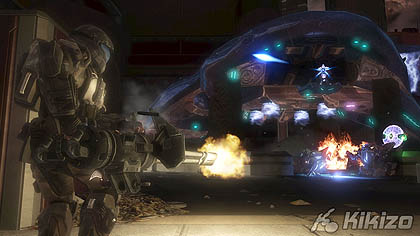Bungie Takes Us Through Halo 3: ODST
Chief's on vacation but the fight's far from finished! Bungie's Lars Baaken opens the door to the first standalone Halo expansion, as we seek answers and get hands-on time.
Page 2
Lars dips his toe into a flashback escapade involving Dutch, the squad's requisite carrot-topped hard man, as he and another ODST rig a bridge with explosives a few hundred metres ahead of a Covenant invasion force. Several hours later, the Rookie stares disconsolately at the ruined bridge and the swirling flame-ridden structures behind it. This affecting causal interplay applies to many of the flashback missions, we're told, the game's temporal double vision leaving you geographically cut off in the present. "The past is another country," and all that.
While Lars remains tight-lipped, again, as to how far ODST will lean towards the role of amateur detective, a few possibilities (and possible limitations) can be glimpsed in the new combat toolset. Lacking the stature, speed, ambidexterity, motion trackers and recharging personal shields of their chunky SPARTAN comrades, the ODST are better suited to hugging shadows than nutting Brutes in the face. To this effect, they sport combat visors with low light vision amplifiers which outline friendlies, enemies and interactive objects in electric felt-tip.
There are some obvious pros in a shoot-out - vertically disadvantaged Grunts are a lot easier to make out amidst the rubble with the visor on - together with a few, subtle cons - strong light sources like the flare of a Brute's shield will whitewash your vision - but more interesting perhaps are the potential parallels with, say, Condemned's array of high-tech forensic tools, or Metroid Prime's backstory-enabling object scanner. We doubt you'll be spending hours at a time photographing blood spatter or rifling through HUD readouts come release day, but there's scope here for some fine interactive first-person storytelling (and even, dare we say it, puzzling) to counterbalance the usual bombastic Halo cut scenes.
In the personality of the Superintendent, who permeates and controls New Mombasa's remaining computer systems, there's also scope for a "living, breathing" setting of another sort: unable to communicate directly, your binary-coded ally will fiddle with mechanisms like holographic billboards to make himself known. A developer like Valve or 2K Boston might have built this up into something engagingly uncanny, the environment itself becoming a component of the Superintendent's personality, but psychological shenanigans are apparently off the menu here.
"It never gets too intense," Lars explains. "He's more guiding you than anything else. I don't think I showed it off very well in the demo, but when you're walking around you'll see signs change, telling you what you should be doing. It's always really simple, maybe it's just 'keep right' with an arrow on it. And those things are happening, and it's not really called attention to - it's more if you're paying attention you'll see these things happening around you. It's not really overt. So he's doing things like placing beacons on your overhead map, but he'll never be like 'Go exactly right here and do this.'"
"So he's not going to turn out like GlaDOS, then," we ask, just to be sure.
"No."
"Shame." Everybody laughs. Philistines.
Combat will shoulder the bulk of the story's running length, of course - Microsoft's Andy Irving bills it as "bigger than most FPS campaigns", but Lars tells us it's a little shorter than that of Halo 3, providing you don't muck around - and while there's not much thus far in the way of new weapons or enemies, the original game's AI has been remodelled with an open world in mind.
"We have a squad patrol system, which didn't exist in Halo 3, that allows us to set up Covenant patrols in the city," Lars details. "And so there are actual, real, randomly generated patrols that are being dropped off in Phantoms. So there are not only very well-crafted encounters that are specific to certain points in the story arc, in certain parts of the city, but there are also multiple things that happen that are basically random.
"And much like Halo is known for - every time you play the game it's going to be a little bit different, which is pretty cool and it makes New Mombasa feel pretty unique, because you never know when a Covenant dropship is going to come in and reinforce the guys you're fighting, or another patrol starts coming down this side street that you weren't expecting."











 Satoru Iwata Video Interview - the late Nintendo president spoke with Kikizo in 2004 as 'Nintendo Revolution' loomed.
Satoru Iwata Video Interview - the late Nintendo president spoke with Kikizo in 2004 as 'Nintendo Revolution' loomed. Kaz Hirai Video Interview - the first of Kikizo's interviews with the man who went on to become global head of Sony.
Kaz Hirai Video Interview - the first of Kikizo's interviews with the man who went on to become global head of Sony. Ed Fries Video Interview - one of Xbox's founders discusses an epic journey from Excel to Xbox.
Ed Fries Video Interview - one of Xbox's founders discusses an epic journey from Excel to Xbox. Yu Suzuki, the Kikizo Interview - we spend time with one of gaming's most revered creators.
Yu Suzuki, the Kikizo Interview - we spend time with one of gaming's most revered creators. Tetris - The Making of an Icon: Alexey Pajitnov and Henk Rogers reveal the fascinating story behind Tetris
Tetris - The Making of an Icon: Alexey Pajitnov and Henk Rogers reveal the fascinating story behind Tetris Rare founders, Chris and Tim Stamper - their only interview? Genuinely 'rare' sit down with founders of the legendary studio.
Rare founders, Chris and Tim Stamper - their only interview? Genuinely 'rare' sit down with founders of the legendary studio. The History of First-Person Shooters - a retrospective, from Maze War to Modern Warfare
The History of First-Person Shooters - a retrospective, from Maze War to Modern Warfare